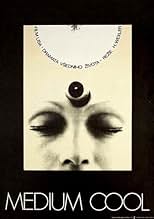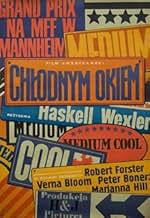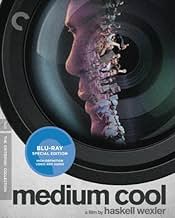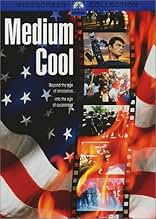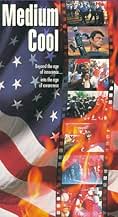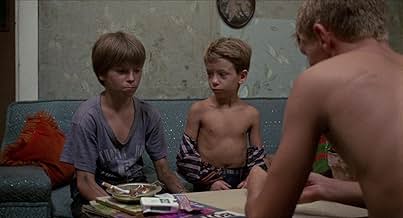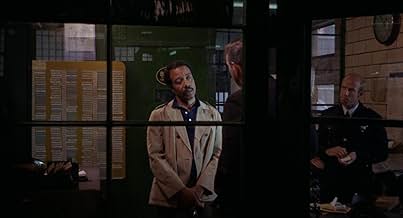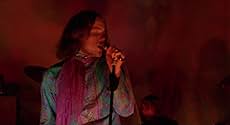AVALIAÇÃO DA IMDb
7,2/10
5 mil
SUA AVALIAÇÃO
Um jornalista de televisão está pessoalmente envolvido na violência que ocorre em torno da Convenção Nacional Democrata de 1968.Um jornalista de televisão está pessoalmente envolvido na violência que ocorre em torno da Convenção Nacional Democrata de 1968.Um jornalista de televisão está pessoalmente envolvido na violência que ocorre em torno da Convenção Nacional Democrata de 1968.
- Prêmios
- 2 vitórias e 4 indicações no total
Avaliações em destaque
A rare directorial outing by all-time great cinematographer Wexler, this is generally acknowledged as the most politically radical film ever produced by a major studio. In freewheeling, semi-improvised, ideologically calculated scene after scene, it depicts an apolitical television cameraman's awakening of consciousness and abandonment of the role of passive observer. The class and race politics are four notches up on any comparable contemporary studio feature, that's for sure - with the surprisingly patient explanation of how 6-o-clock-news ideology oppresses minority communities, leading in to a love affair with a working-class single mother instead of some vanguard hippie, you could even argue that this Americanization of Godard has better ideological legs than the master himself. Sure it meanders a tad, and the stylistics can date, but there's nothing else in any movie ever that compares with the climax, as the actors make their way through actual documentary footage of the 1968 Democratic convention and attendant street battles. I mean, how did such a finely balanced mix of integrated narrative, Euro-tics, American underground film and straight-up documentary even occur to them? And how did they then manage to actually pull it off with honors? Pretty damned impressive.
Interesting approach to revealing the world of photo-journalism, news journalism, and political activism, conceived and directed by awardwinning cinematographer Haskell Wexler. Fictional narrative features a Chicago TV news crew intertwined with actual news footage in and around the Democratic Convention of 1968.
There is a good balance between the fiction and non-fiction elements in as much as Wexler attempts to make his point. The fictional story line (a love story) is real enough to keep us watching and deflective enough to make the harsh realities of the non-fiction elements palatable.
Attention to detail defines Medium Cool as a very personal film for Wexler. There definitely is a political perspective. Second and third viewings will call attention to painstaking perfectionism in construction of shots, timing, and pace--the subject matter and cinematic approach (low budget, hand-held, docu-style) may suggest a `student film' so don't be confused. This is an extremely well-crafted highly professional product. Nice interjects of great era-defining music compliment the visuals.
Inventive, some say ground-breaking, certainly well worth watching.
There is a good balance between the fiction and non-fiction elements in as much as Wexler attempts to make his point. The fictional story line (a love story) is real enough to keep us watching and deflective enough to make the harsh realities of the non-fiction elements palatable.
Attention to detail defines Medium Cool as a very personal film for Wexler. There definitely is a political perspective. Second and third viewings will call attention to painstaking perfectionism in construction of shots, timing, and pace--the subject matter and cinematic approach (low budget, hand-held, docu-style) may suggest a `student film' so don't be confused. This is an extremely well-crafted highly professional product. Nice interjects of great era-defining music compliment the visuals.
Inventive, some say ground-breaking, certainly well worth watching.
Movies have a way of capturing the moment better than recreating it. I can only dread what a recreated 1968 in Chicago would look like from a Hollywood perspective. It would probably resemble something out of Forrest Gump. But Medium Cool happened to capture some brutal fight scenes with police in Chicago as well as scenes from the black ghettos. You can't recreate this stuff. This isn't a documentary but cinema verité and combines fiction and non-fictional elements. It's all shot with Chicago of 68 in the background. A landmark and infamous year for the US with the assassinations of RFK and MLK as well as the 1968 Democratic National Convention which was met with severe state repression. The state wasn't negotiating at this time, it was brutally sending men off to war and attacking those at home with the hired goons of the police force.
It's a great movie which manages to combine fiction and non-fiction and shows us what the sixties were really like. It wasn't all love beads and LSD, although there is an amusing psychedelic sequence which takes place in a club.
I think what I liked most was that even people who were non-political were being dragged into the politics of the time. Events were that serious at the time and people had to begin picking sides, the pleasant, white, middle-class interior of the Chicago DNC or outside fighting and raging against the police.
It's a great movie which manages to combine fiction and non-fiction and shows us what the sixties were really like. It wasn't all love beads and LSD, although there is an amusing psychedelic sequence which takes place in a club.
I think what I liked most was that even people who were non-political were being dragged into the politics of the time. Events were that serious at the time and people had to begin picking sides, the pleasant, white, middle-class interior of the Chicago DNC or outside fighting and raging against the police.
This film is a mixture of documentary footage and conventional narrative.
It tells the story of a tough news camera-man (Robert Forster) who falls for a young widow (Verna Bloom) and befriends her thirteen-year-old son, against the back-drop of the riots in Chicago in 1968.
The film utilises both professional actors and non-professionals, to very good effect. In fact there are scenes, such as the riot sequences, where there is a genuine sense of danger.
The main flaw in the film is that the love story is not well-handled and often quite dull, the far more interesting events are happening elsewhere.
This is a deeply political work and is savagely critical of the callous and cynical media, which distorts people's perceptions of the world.
Worth watching for anyone interested in the sixties, political cinema or American independent film.
Great soundtrack too.
It tells the story of a tough news camera-man (Robert Forster) who falls for a young widow (Verna Bloom) and befriends her thirteen-year-old son, against the back-drop of the riots in Chicago in 1968.
The film utilises both professional actors and non-professionals, to very good effect. In fact there are scenes, such as the riot sequences, where there is a genuine sense of danger.
The main flaw in the film is that the love story is not well-handled and often quite dull, the far more interesting events are happening elsewhere.
This is a deeply political work and is savagely critical of the callous and cynical media, which distorts people's perceptions of the world.
Worth watching for anyone interested in the sixties, political cinema or American independent film.
Great soundtrack too.
This film is better upon the second viewing, the first time I saw this I thought it was somewhat dated or boring, I couldn't have been more wrong. Initially I watched this film because it was directed by Haskell Wexler whose work I admire, and I'm from Chicago and had heard it shows much of the city and the riots of 68. I enjoyed seeing the city forty years ago to see what was the same and what had changed, much has changed yet much remains the same from what I have seen of the people, places, buildings etc. It was great to see the Kinetic Playground on there, Chicago's electric ballroom, and other area's such as Lincoln Park. On the second viewing, I realized that this is a very important film in that it adroitly captures a moment in time, a moment we can never have again that is lost forever, that one second in our history that pivoted us as a nation between innocence and awareness and possibly that crucial moment which has brought us to the point we are at today. This movie is very important as a document of history, not to mention how well it's shot. The angles, the color, the way he goes in and out of focus make this a true gem that gets better the more you see it. Great soundtrack as well, Zappa, Mike Bloomfield and others.
Você sabia?
- CuriosidadesThe line "Look out, Haskell, it's real!" was actually dubbed in after the shooting. It was supposedly what Haskell Wexler was thinking to himself and he wanted to include it.
- Erros de gravaçãoWhen Eileen enters the L looks for Harold, she is wearing a white hair band, but when they show her sitting on the L, the hair band is missing.
- Citações
John Cassellis: If I gotta be afraid in order for your argument to work, then you got no argument.
- Cenas durante ou pós-créditosStuds Terkel is credited as "Our Man in Chicago".
- Versões alternativasDue to copyright disputes, all video releases feature some different songs on the soundtrack from the theatrical version.
- ConexõesEdited into O Show Não Pode Parar (2002)
- Trilhas sonorasSweet Georgia Brown
by Ben Bernie, Kenneth Casey and Maceo Pinkard
Performed by Brother Bones
Courtesy of Tempo Records
Played during roller derby scene
Principais escolhas
Faça login para avaliar e ver a lista de recomendações personalizadas
- How long is Medium Cool?Fornecido pela Alexa
Detalhes
Bilheteria
- Orçamento
- US$ 800.000 (estimativa)
- Tempo de duração
- 1 h 51 min(111 min)
- Mixagem de som
- Proporção
- 1.85 : 1
Contribua para esta página
Sugerir uma alteração ou adicionar conteúdo ausente


